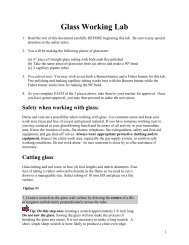Chapter 15: Solutions - Weironline.net
Chapter 15: Solutions - Weironline.net
Chapter 15: Solutions - Weironline.net
You also want an ePaper? Increase the reach of your titles
YUMPU automatically turns print PDFs into web optimized ePapers that Google loves.
a<br />
b<br />
Water<br />
Sucrose<br />
Figure <strong>15</strong>-17<br />
The vapor pressure of a pure<br />
solvent a is greater than the<br />
vapor pressure of a solution containing<br />
a nonvolatile solute b .<br />
Table <strong>15</strong>-4<br />
Molal Boiling-Point<br />
Elevation Constants (K b )<br />
Boiling K b<br />
Solvent point (°C) (°C/m)<br />
Water 100.0 0.512<br />
Benzene 80.1 2.53<br />
Carbon<br />
tetrachloride 76.7 5.03<br />
Ethanol 78.5 1.22<br />
Chloroform 61.7 3.63<br />
472 <strong>Chapter</strong> <strong>15</strong> <strong>Solutions</strong><br />
Vapor Pressure Lowering<br />
In <strong>Chapter</strong> 13, you learned that vapor pressure is the pressure exerted in a<br />
closed container by liquid particles that have escaped the liquid’s surface and<br />
entered the gaseous state. In a closed container at constant temperature and<br />
pressure, the solvent particles reach a state of dynamic equilibrium, escaping<br />
and reentering the liquid state at the same rate. The vapor pressure for a closed<br />
container of pure water is shown in Figure <strong>15</strong>-17a.<br />
Experiments show that adding a nonvolatile solute (one that has little tendency<br />
to become a gas) to a solvent lowers the solvent’s vapor pressure. The<br />
particles that produce vapor pressure escape the liquid phase at its surface.<br />
When a solvent is pure, as shown in Figure <strong>15</strong>-17a, its particles occupy the<br />
entire surface area. However, when the solvent contains solute, as shown in<br />
Figure <strong>15</strong>-17b, a mix of solute and solvent particles occupies the surface<br />
area. With fewer solvent particles at the surface, fewer particles enter the<br />
gaseous state, and the vapor pressure is lowered. The greater the number of<br />
solute particles in a solvent, the lower the resulting vapor pressure. Thus,<br />
vapor pressure lowering is due to the number of solute particles in solution<br />
and is a colligative property of solutions.<br />
You can predict the relative effect of a solute on vapor pressure based on<br />
whether the solute is an electrolyte or a nonelectrolyte. For example, one mole<br />
each of the solvated nonelectrolytes glucose, sucrose, and ethanol molecules<br />
has the same relative effect on the vapor pressure. However, one mole each<br />
of the solvated electrolytes sodium chloride, sodium sulfate, and aluminum<br />
chloride has an increasingly greater effect on vapor pressure because of the<br />
increasing number of ions each produces in solution.<br />
Boiling Point Elevation<br />
Because a solute lowers a solvent’s vapor pressure, it also affects the boiling<br />
point of the solvent. Recall from <strong>Chapter</strong> 13 that the liquid in a pot on your<br />
stove boils when its vapor pressure equals atmospheric pressure. When the<br />
temperature of a solution containing a nonvolatile solute is raised to the boiling<br />
point of the pure solvent, the resulting vapor pressure is still less than the<br />
atmospheric pressure and the solution will not boil. Thus, the solution must<br />
be heated to a higher temperature to supply the additional ki<strong>net</strong>ic energy<br />
needed to raise the vapor pressure to atmospheric pressure. The temperature<br />
difference between a solution’s boiling point and a pure solvent’s boiling point<br />
is called the boiling point elevation.<br />
For nonelectrolytes, the value of the boiling point elevation, which is symbolized<br />
�T b , is directly proportional to the solution’s molality.<br />
�T b = K b m<br />
The molal boiling point elevation constant, K b , is the difference in boiling<br />
points between a 1m nonvolatile, nonelectrolyte solution and a pure solvent.<br />
It is expressed in units of °C/m and varies for different solvents. Values of K b<br />
for several common solvents are found in Table <strong>15</strong>-4. Note that water’s K b<br />
value is 0.512°C/m. This means that a 1m aqueous solution containing a nonvolatile,<br />
nonelectrolyte solute boils at 100.512°C, a temperature 0.512°C<br />
higher than pure water’s boiling point of 100.0°C.<br />
Like vapor pressure lowering, boiling point elevation is a colligative property.<br />
The value of the boiling point elevation is directly proportional to the<br />
solution’s solute molality, that is, the greater the number of solute particles<br />
in the solution, the greater the boiling point elevation.




